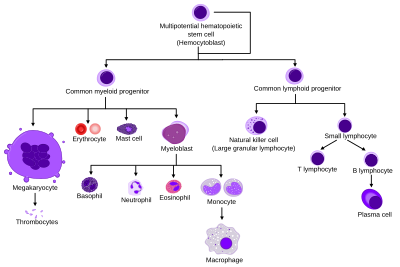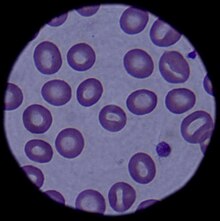370:
the past, counting the cells in a patient's blood was performed manually, by viewing a slide prepared with a sample of the patient's blood under a microscope. Today, this process is generally automated by use of an automated analyzer, with only approximately 10-20% of samples now being examined manually. Abnormally high or low counts may indicate the presence of many forms of disease, and hence blood counts are amongst the most commonly performed blood tests in medicine, as they can provide an overview of a patient's general health status.
91:
99:
27:
193:
612:
307:
The normal range (99% of population analyzed) for platelets is 150,000 to 450,000 per cubic millimeter. If the number of platelets is too low, excessive bleeding can occur. However, if the number of platelets is too high, blood clots can form thrombosis, which may obstruct blood vessels and result in
369:
A complete blood count (CBC) is a test panel requested by a doctor or other medical professional that gives information about the cells in a patient's blood. A scientist or lab technician performs the requested testing and provides the requesting medical professional with the results of the CBC. In
141:
from tissues to the lungs to be exhaled. Red blood cells are the most abundant cell in the blood, accounting for about 40-45% of its volume. Red blood cells are circular, biconcave, disk-shaped and deformable to allow them to squeeze through narrow capillaries. They do not have a nucleus. Red blood
304:. The average lifespan of a platelet is normally just 5 to 9 days. Platelets are a natural source of growth factors. They circulate in the blood of mammals and are involved in hemostasis, leading to the formation of blood clots. Platelets release thread-like fibers to form these clots.
343:, which stimulates the deposition of extracellular matrix. Both of these growth factors have been shown to play a significant role in the repair and regeneration of connective tissues. Other healing-associated growth factors produced by platelets include
153:. In adults, about 2.4 million RBCs are produced each second. The normal RBCs count is 4.5 to 5 millions per cu.mm. RBCs have a lifespan of approximately 100-120 days. After they have completed their lifespan, they are removed from the bloodstream by the
320:, or blockage of blood vessels to other parts of the body, such as the extremities of the arms or legs. An abnormality or disease of the platelets is called a thrombocytopathy, which can be either a low number of platelets (
405:, a new field of medicine, was established. Even though agents for staining tissues and cells were available, almost no advances were made in knowledge about the morphology of blood cells until 1879, when
277:. There are individual terms for the lack or overabundance of specific types of white blood cells. The number of white blood cells in circulation is commonly increased in the incidence of
324:), a decrease in function of platelets (thrombasthenia), or an increase in the number of platelets (thrombocytosis). There are disorders that reduce the number of platelets, such as
178:
Erythrocyte sedimentation rate (ESR) is the rate at which RBCs sink to the bottom (when placed in a vertical column after adding an anticoagulant). Normal values of ESR are:
355:(VEGF). Local application of these factors in increased concentrations through platelet-rich plasma (PRP) has been used as an adjunct to wound healing for several decades.
545:
Ross DW, Ayscue LH, Watson J, Bentley SA (September 1988). "Stability of hematologic parameters in healthy subjects. Intraindividual versus interindividual variation".
389:, also Dutch, was the first to draw an illustration of "red corpuscles", as they were called. No further blood cells were discovered until 1842 when French physician
78:(thrombocytes). Together, these three kinds of blood cells add up to a total 45% of the blood tissue by volume, with the remaining 55% of the volume composed of
227:. There are a variety of types of white blood cells that serve specific roles in the human immune system. WBCs constitute approximately 1% of the blood volume.
401:, a British physician, simultaneously. Both men believed that both red and white cells were altered in disease. With these discoveries,
20:
426:
Maton, Anthea; Jean
Hopkins; Charles William McLaughlin; Susan Johnson; Maryanna Quon Warner; David LaHart; Jill D. Wright (1993).
464:
329:
529:
352:
300:, are very small, irregularly shaped clear cell fragments, 2–3 μm in diameter, which derive from fragmentation of
504:
439:
325:
196:
Artificially colored electron micrograph of blood cells. From left to right: erythrocyte, thrombocyte, leukocyte.
344:
336:
616:
348:
398:
495:
Alberts, Bruce; Johnson, Alexander; Lewis, Julian; Raff, Martin; Roberts, Keith; Walter, Peter (2002).
409:
published his technique for staining blood films and his method for differential blood cell counting.
160:
Mature red blood cells are unique among cells in the human body in that they lack a nucleus (although
102:
The darker red blood syringes have deoxygenated blood, whereas the brighter red have oxygenated blood.
637:
220:
146:
31:
386:
239:
313:
129:-containing protein that gives red blood cells their color and facilitates transportation of
632:
364:
282:
8:
425:
317:
212:
589:
562:
525:
500:
460:
435:
428:
554:
321:
224:
215:
and foreign materials. They are produced and derived from multipotent cells in the
200:
94:
Red and white human blood cells as seen under a microscope using a blue slide stain
71:
382:
was the first person to observe red blood cells under a microscope, and in 1695,
90:
390:
642:
394:
379:
301:
150:
138:
118:
106:
67:
55:
580:
Hajdu, Steven I. (2003). "A Note from
History: The Discovery of Blood Cells".
626:
481:
208:
161:
59:
558:
98:
593:
406:
393:
discovered platelets. The following year leukocytes were first observed by
383:
274:
235:
172:
79:
566:
259:
251:
247:
231:
216:
192:
402:
332:(TTP), that typically cause thromboses, or clots, instead of bleeding.
270:
255:
122:
26:
278:
263:
243:
520:
Kumar, Vinay; Abbas, Abul K.; Fausto, Nelson; Aster, Jon C. (2010).
223:. Leukocytes are found throughout the body, including the blood and
340:
293:
75:
19:"Hemocyte" redirects here. For the invertebrate immune cell, see
285:
are based on the inappropriate production of white blood cells.
611:
309:
168:
154:
130:
114:
30:
Diagram showing the development of different blood cells from
63:
167:
The condition of having too few red blood cells is known as
134:
126:
335:
Platelets release a multitude of growth factors including
544:
494:
351:(IGF-1), platelet-derived epidermal growth factor, and
519:
459:(3rd ed.). Philadelphia: Elsevier. p. 434.
269:
The condition of having too few white blood cells is
142:
cells are much smaller than most other human cells.
434:. Englewood Cliffs, New Jersey, US: Prentice Hall.
427:
524:(8th ed.). Philadelphia: Saunders/Elsevier.
624:
522:Robbins and Cotran Pathologic Basis of Disease
238:, distinguished by the presence or absence of
479:
455:Boron, Walter F.; Boulpaep, Emile L. (2017).
454:
211:involved in defending the body against both
145:RBCs are formed in the red bone marrow from
499:(4th ed.). New York: Garland Science.
21:hemocyte (invertebrate immune system cell)
339:(PDGF), a potent chemotactic agent, and
191:
97:
89:
25:
358:
242:in the cytoplasm. Granulocytes include
625:
547:American Journal of Clinical Pathology
397:, a French professor of medicine, and
579:
66:. Major types of blood cells include
187:
330:thrombotic thrombocytopenic purpura
230:White blood cells are divided into
13:
353:vascular endothelial growth factor
184:• 4 to 7 mm per hour in females.
85:
14:
654:
604:
82:, the liquid component of blood.
610:
326:heparin-induced thrombocytopenia
181:• 3 to 5 mm per hour in males.
573:
538:
513:
488:
473:
448:
419:
345:basic fibroblast growth factor
337:platelet-derived growth factor
16:Cell produced by hematopoiesis
1:
497:Molecular Biology of the Cell
412:
373:
349:insulin-like growth factor 1
288:
7:
273:, while having too many is
171:, while having too many is
10:
659:
362:
18:
378:In 1658 Dutch naturalist
430:Human Biology and Health
258:. Agranulocytes include
221:hematopoietic stem cells
147:hematopoietic stem cells
62:and found mainly in the
32:hematopoietic stem cells
480:Basic Biology (2015).
387:Antoni van Leeuwenhoek
197:
149:in a process known as
103:
95:
35:
559:10.1093/ajcp/90.3.262
314:myocardial infarction
283:hematological cancers
195:
101:
93:
29:
619:at Wikimedia Commons
365:Complete blood count
359:Complete blood count
164:do have a nucleus).
207:, are cells of the
125:. Hemoglobin is an
121:through the use of
457:Medical Physiology
318:pulmonary embolism
213:infectious disease
198:
104:
96:
74:(leukocytes), and
44:hematopoietic cell
36:
615:Media related to
466:978-0-323-42796-8
308:such events as a
201:White blood cells
188:White blood cells
72:white blood cells
58:produced through
650:
614:
598:
597:
582:Ann Clin Lab Sci
577:
571:
570:
542:
536:
535:
517:
511:
510:
492:
486:
485:
477:
471:
470:
452:
446:
445:
433:
423:
322:thrombocytopenia
225:lymphatic system
70:(erythrocytes),
34:to mature cells.
658:
657:
653:
652:
651:
649:
648:
647:
638:1658 in science
623:
622:
607:
602:
601:
578:
574:
543:
539:
532:
518:
514:
507:
493:
489:
478:
474:
467:
453:
449:
442:
424:
420:
415:
399:William Addison
376:
367:
361:
291:
190:
137:to tissues and
107:Red blood cells
88:
86:Red blood cells
68:red blood cells
42:(also called a
24:
17:
12:
11:
5:
656:
646:
645:
640:
635:
621:
620:
606:
605:External links
603:
600:
599:
572:
537:
531:978-1416031215
530:
512:
505:
487:
472:
465:
447:
440:
417:
416:
414:
411:
395:Gabriel Andral
380:Jan Swammerdam
375:
372:
363:Main article:
360:
357:
302:megakaryocytes
290:
287:
189:
186:
151:erythropoiesis
139:carbon dioxide
119:carbon dioxide
87:
84:
15:
9:
6:
4:
3:
2:
655:
644:
641:
639:
636:
634:
631:
630:
628:
618:
613:
609:
608:
595:
591:
587:
583:
576:
568:
564:
560:
556:
552:
548:
541:
533:
527:
523:
516:
508:
506:0-8153-4072-9
502:
498:
491:
483:
482:"Blood cells"
476:
468:
462:
458:
451:
443:
441:0-13-981176-1
437:
432:
431:
422:
418:
410:
408:
404:
400:
396:
392:
388:
385:
381:
371:
366:
356:
354:
350:
346:
342:
338:
333:
331:
327:
323:
319:
315:
311:
305:
303:
299:
295:
286:
284:
280:
276:
272:
267:
265:
261:
257:
253:
249:
245:
241:
237:
236:agranulocytes
233:
228:
226:
222:
218:
214:
210:
209:immune system
206:
202:
194:
185:
182:
179:
176:
174:
170:
165:
163:
162:erythroblasts
158:
156:
152:
148:
143:
140:
136:
132:
128:
124:
120:
116:
112:
108:
100:
92:
83:
81:
77:
73:
69:
65:
61:
60:hematopoiesis
57:
53:
49:
45:
41:
33:
28:
22:
588:(2): 237–8.
585:
581:
575:
553:(3): 262–7.
550:
546:
540:
521:
515:
496:
490:
475:
456:
450:
429:
421:
407:Paul Ehrlich
391:Alfred Donné
384:microscopist
377:
368:
334:
306:
298:thrombocytes
297:
292:
275:leukocytosis
268:
232:granulocytes
229:
204:
199:
183:
180:
177:
173:polycythemia
166:
159:
144:
117:and collect
111:erythrocytes
110:
105:
51:
47:
43:
39:
37:
633:Blood cells
617:Blood cells
260:lymphocytes
252:neutrophils
248:eosinophils
217:bone marrow
113:pors carry
627:Categories
413:References
403:hematology
271:leukopenia
256:mast cells
205:leukocytes
123:hemoglobin
52:hematocyte
40:blood cell
374:Discovery
328:(HIT) or
294:Platelets
289:Platelets
279:infection
264:monocytes
244:basophils
219:known as
133:from the
76:platelets
594:12817630
347:(bFGF),
341:TGF beta
240:granules
48:hemocyte
567:3414599
281:. Many
54:) is a
592:
565:
528:
503:
463:
438:
310:stroke
254:, and
169:anemia
155:spleen
131:oxygen
115:oxygen
80:plasma
643:Blood
296:, or
135:lungs
64:blood
50:, or
590:PMID
563:PMID
526:ISBN
501:ISBN
461:ISBN
436:ISBN
262:and
234:and
127:iron
56:cell
555:doi
203:or
109:or
629::
586:33
584:.
561:.
551:90
549:.
316:,
312:,
266:.
250:,
246:,
175:.
157:.
46:,
38:A
596:.
569:.
557::
534:.
509:.
484:.
469:.
444:.
23:.
Text is available under the Creative Commons Attribution-ShareAlike License. Additional terms may apply.



